Parks & Sancturies
For Wildlife Tours CLICK HERE
Mudumalai Sanctuaries
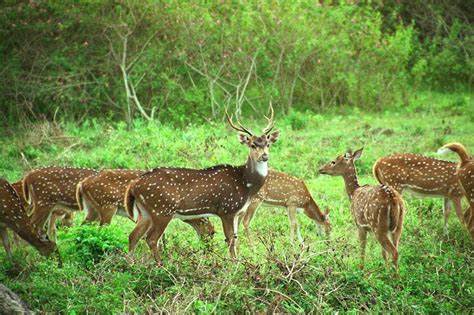
Mudumalai Wildlife Sanctuary : It is located at an elevation of 1140 mts at the tri point junction of the States of Kerala, Karnataka and Tamil Nadu . First of its kind to be set up in India and forms a part of Jawaharlal Nehru National Park. It's area is around 321 Sq.Kms. Tropical Evergreen Forest, moist Deciduous Forest, moist Teak Forest, dry Teak Forest and secondary Grassland Swamps are found here.
It is an exciting place to see animals like Tiger, Panther, Elephant, Gaur, Mouse deer, Sloth bear , Sambar, Spotted Deer, Barking Deer, Blackbuck, Malabar Giant Squirrel, Flying Squirrel, Four-horned Antelope (Chowsingha), Wild Dog, Striped Hyena, Small Indian Civet , Wild Boar, Porcupine, Slender Lories and so on. Tigers are largely elusive but leopards on the move are frequently seen. Ombetta vayal, a swampy area is mid way between upper Kargudi and Mudumalai Game Hut is a place to lookout for Elephant and Bison. The Sanctuary is well connected by National Highway. All buses plying from Mysore to Udhagamandalam stops at the Reception Centre at Theppakkadu. Theppakkadu Elephant Camp established in 1972 is a big attraction of Mudumalai Sanctury. It is also approachable from Udhagamandalam by two different routes: One is 36 Kms via Kalhatty with 36 hairpin bends through natural forests and the other is 67 Kms via Gudalur. Sanctuary can also be approached travelling 90 Kms by road from Mysore. Nearest Railway Stations are Udhagamandalam 67 Kms and Mysore 90 Kms. For accommodation and more details about the Theppakkadu Camp, please Contact: Reception Range Officer, Mudumalai Wildlife Sanctuary on Phone No:0423-526235. Other Information Location In the Nilgiris district 67 kms from Ootacamund on the Ooty- Mysore Road . Area 321 Sq Kms Forest type Primarily moist deciduous. Tends to become the dry deciduous variety towards Bandipur. Mainly mixed forests with bamboos. Animals found Elephant, gaur, sambar, chital, dhole pather, tiger, sloth bear, Python, barking deer, four-horned antelope, common langur, Otter, crocodiles and a variety of birds and reptiles. Annual rainfall About 2300 mm. Nearest airport Coimbatore is 160 kms away. Nearest Railway station Udhagamandalam is 64 kms away. Mysore is 95 kms away . /Best season Throughout the year (Except June to August) Accommodation Forest Rest Houses at Abhayaranyam, Kargudi, Masinagudi, and Teppakadu. Catering arrangements are available.
Other facilities Motor Vehicles and riding elephants are available for hire. For more details The Wildlife Warden, Mahalingam Buildings, Coonoor Road, Udhagamandalam - 643 001. This forms part of the Nilgiris Biosphere Reserve, which is the first biosphere reserve formed in India. The Biosphere reserve portion extends to the adjoining states of Kerala and Karnataka also. The 2537.6 sq. kms of NBR in Tamil Nadu covers all the forests of the Nilgiris district and a part of Coimbatore and Periyar districts.
Vallanadu Sanctuaries
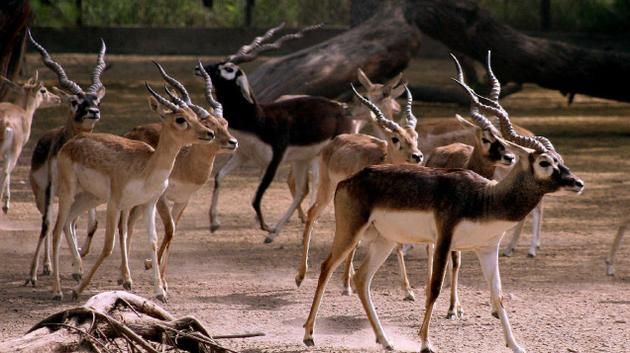
Vallanadu Deer Sanctuary : This is 35 kms from Thoothukudi on the Tirunelveli Thoothukudi highway in the Srivaikundam Tauk and located on an isolated Hilly area measuring 64 acres. This Sanctuary has been specially created for the protection of Blackbucks. Vallanadu is the southern most place in India where a natural population of Blackbuck exists. The Blackbuck population grazing in the hilly area is a common sight to watch. Apart from Black Bucks; Spotted Deer, Macaques, Jungle cat, Mongoose and wild hares are some members of the Fauna population found in this Sanctuary. The Forest Department has fenced the entire area for the protection of these blackbucks. Because of the rapid expansion activities, Poaching in sanctuaries and dwindling agriculture resources; Black Buck population is confined only to four National Parks: Guindy in Chennai, Mudumalai, Point Calimere in Napapattinam and Vallanadu in Tuticorin .
Other Information Location Thoothukudi District Area 16.41 Sq Kms Forest type Scrub forests Animals found Blackbuck, Spotted Deer, Macaques, Jungle Cat, Mongoose, Wild hares, and other animals Annual rainfall 758.0 mm Nearest airport Madurai ? 165 kms Nearest Railway station Tirunelveli Junction, 20 km Best season Throughout the year Accommodation Hotels at Tirunelveli For more details The district Forest Officer, Tirunelveli Division, Kokirakulam, Tirunelveli ? 627 009.Viralimalai Sanctuary
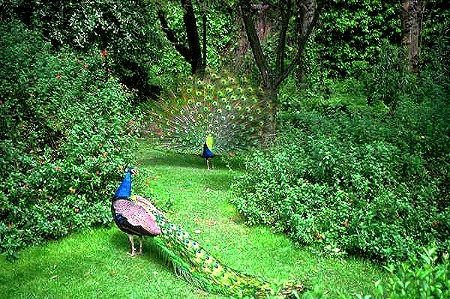
Viralimalai Sanctuary is 30 kms from Tiruchirpalli and 40 kms from Pudukottai. The Viralimalai is a Bird Sanctuary, particularly a natural sanctuary of peacocks. Large number of those birds are found in this Hill zone. The Viralimalai town, Temple and Peacock Sanctuary have been declared and funded as a Heritage zone by the order of the Governor. The town is bestowed with a large number of wild peacocks, which roam around the Murugan temple. The sanctuary is one of the best places to watch peacocks. There are at least six species of peacock pheasants distributed throughout South East Asia, though the Palawan Peacock Pheasant or "Tandikan" (Polyplectron Emphanum) is by far the most spectacularly coloured of these beautiful birds.
How to reach Air: The nearest airport is at Tiruchirapalli (30-km). Rail: Tiruchirapalli junction is a main junction on the southern railway. It connects Chennai, Chidambaram, Madurai, Tuticorin, Tirunelveli, Tenkasi, Kollam, Rameswaram, Bangalore, Coimbatore, Kochi , Kanyakumari and Mangalore. Pudukkottai is also well connected by rail with the important places within and beyond the state. Road: There are regular buses from TiruchirapallPoint Calimere Sanctuary
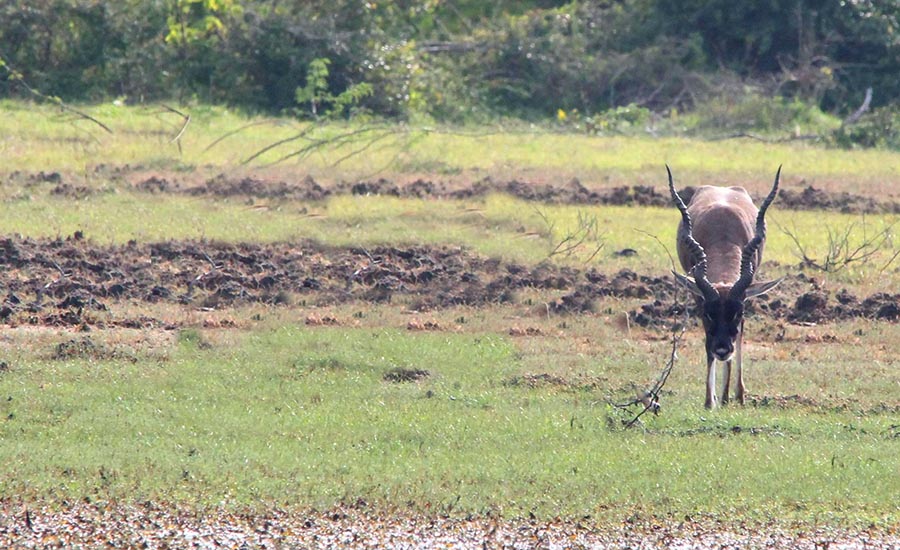
Calimere Wild Life Sanctuary : It is around 70 kms from Nagapattinam and 11Kms from Vedaranyam. Point Calimere Wildlife Sanctuary was created in 1967 for conservation of Blackbuck, an endangered and endemic species of India. Point Calimere encompasses 17.26 sq KM of sandy coast fringed by saline swamps and thorny scrub around the backwaters. Migratory curlews, Terns, Plovers, Sandpipers and Shanks nest in the tidal mud flats from October to March. Black bucks, Spotted Deers, Jackal, Ponies and Wild hare are sighted very often. Flamingo House [Poonarai illam- 04369 - 272424], Forest Rest House are available at Kodikkarai. Alternative accommodation options are available at Vedaranyam.
Other Information: Location In Thanjavur district, where the coastline projects into the sea after taking a sharp turn to the west Area 17.26 Sq kms Forest type Consists of tidal swamps, evergreen forests and mangroves . Animals found The sanctuary is famous for its Flamingos and Blackbuck. A vast variety of water birds such as Teals, Gulls, Terns, Plovers, etc. can also be seen during winter months. The mammals include the chital, wild boar etc. The water birds in the great swamp and the Dolphins and Turtles that often come quite close to the shore is an interesting scene to watch. Annual rainfall About 1500 mm. Nearest Airport Thiruchirappalli - 225 kms Nearest Railway station Thiruthuraipoondi - 42 kms Best season For water birds November to February; and one can see the blackbuck and chital all the year round. Accommodation Forest Rest Houses at Point Calimere. Catering arrangements are provided. Other facilities Boats available for hire For more details The Wildlife Warden, Point Calimere Wildlife Sanctuary, 110, Public Officers Road, Nagapattinam - 611 001.Indira Gandhi National Sanctuaries
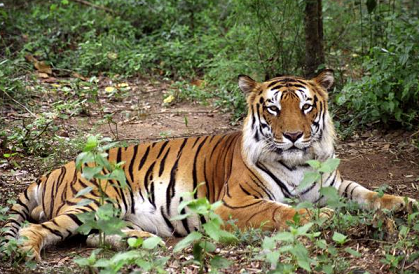
INDIRA GANDHI WILDLIFE SANCTUARY and NATIONAL PARK : There is a 30 Km wide gap [big break in the Western Ghat mountain range] between the Nilgiri Hills to the north and the Anamalai Hills to the South that straddles the Kerala and Tamil Nadu border and serves as a major communication route between them. Highways and Rail Transport connect Palghat with Coimbatore and Pollachi. This huge gap is called as Palghat Gap
T his was originally called as Anamalai Wild Life Sanctuary notified in the year 1974 and established in the year 1976. Later on renamed in honour of former Prime Minister Indira Gandhi’s visit during 1961 . It is located at an altitude of 1400 meters at the Top Slip. The National Park is 108 sq.kms core area of the total 958 Sq. Kms sanctuary zone. Indira Gandhi Wild Life Sanctuary was declared a Project Tiger Zone in the year 2008. Elephants, Gaur, Tiger, Panther, Sloth Bear, Pangolin, Black Headed Oriole, Green Pigeon and Civet cat can be seen in this Sanctuary. Karian and Anaikunthi Sholas, Grass Hills, Waterfalls, Groves, Teak forests, Estates, Dams and Reservoirs add beauty to Anamalai Hills and attracts visitors in large numbers. Elephant Safari and Van services are available at the Top Slip to take the tourists around the Sanctuary. Other Information Location The Anamalai Ranges in Coimbatore District Area 108 Sq. Kms Forest Type Varies from the dry deciduous to the semi-evergreen, evergreen and the wet temperate containing teak, rose wood and many miscellaneous tropical species. Animals found Elephant, Gaur, Tiger, Panther, Sloth bear, Wild boar, Wild dog, Nilgiri langur, Lion-tailed macaque, Sambhar, Four Horned Antelope, Chital, etc. and a host of birds, notably the Pied horn bill and several species of eagles. Annual rainfall 500 mm to 5000 mm, least rainfall is on the eastern slopes and most rainfall is on western slopes. Nearest airport Coimbatore – 75 kms. Nearest Railway station Pollachi 35 kms away. Best season Throughout the year (Except June to August) Accommodation There is a Forest Rest House at Topslip Varagaliar, Amaravathi, Sethumadai. Catering arrangements are available. The Public Works Department (PWD) Rest houses at Udumalpet and Amaravathi, Electricity Board (TNEB) Rest House at Attakatti . Other facilities Motor Vehicles and elephants are available for hire. For more details The Wildlife Warden, 178, Meenakarai Salai, Pollachi - 642001.Mundanthurai Sanctuaries
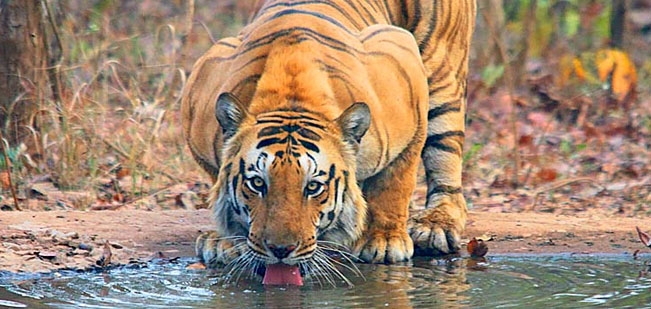
There is nothing to differentiate this sanctuary from the Kalakkadu Sanctuary, except for the absence of the Elephant and the Gaur. Situated in the Thirunelveli district, this sanctuary has dry decidious to tropical wet evergreen forests and patches of reeds in an area of 567 sq. kms.
The animal wealth in this sanctuary includes the Tiger, Bonnet Macaque, Langurs, Slenders Loris, Sloth Bear, Sambhar, Chital and the Wild Dog. This sanctuary is excellent also for the various species of avifauna and varieties of reptiles and insects. Trekking trips along trekking trails can be undertaken with prior permission from the Forest (Wildlife) Department. General Information Location Tirunelveli District. Area 567 Sq Kms Forest type Dry deciduous to tropical wet evergreen forests with patches of reeds. Animals found Tiger, bonnet macaque, langurs, slender loris, sloth bear, sambhar, chital, wild dog etc. Excellent area for bird watching. Annual rainfall Varies from below 1000 mm in lower reaches to nearly 4000 mm in the hills. Nearest airport Madurai ? 200 kms away. Nearest Railway station Ambasamudram 6 kms away. Best season October to January Accommodation Forest Rest House at Mundanthurai with catering arrangements. Public Works Department Rest House at Ambasamudram. E.B. Rest House at Papanasam camp. For more details The Field Director, Project Tiger, NGO ?A? Colony Tirunelveli ? 627 007.Kalakkadu Sanctuaries
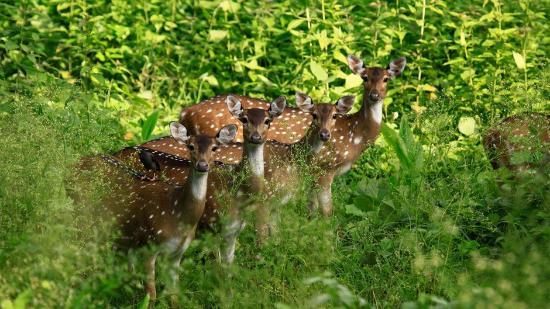
Kalakadu Wild Life Sanctuary: It is the 17th Tiger Reserve in India and the only one in Tamil Nadu, was declared as a Tiger Reserve in 1988, located in an area of 900km². This includes two contiguous Sanctuaries namely Kalakad Sanctuary and Mundanthurai Sanctuary and a part of Kanyakumari Sanctuary. This sanctuary is very popular with a great variety of Flora and Fauna. Short list includes Tiger, Panther, Jackal and Wild dogs among the carnivores; King-cobra, Python and several other snakes among the reptiles population. The Kalakad Sanctuary was declared a forest preserve for the rare lion-tailed macaque, which is easily spotted here. The best season to visit this sanctuary is between March and September. Trekking is allowed here with the prior permission from the officials of Forest (Wildlife) Department. Other attraction in the vicinity is Kudirai Mozhitheri, a natural spring 12 kms from Tiruchendur.
Other Informationtion Location Tirunelveli District Area 223 Sq Kms. Forest type Tropical wet evergreen forests changes to tropical dry deciduous forests in the foothills and to thorn forests further down. Animals found Famous for Lion-Tailed Macaque. All the four species (common Langur, Nilgiri Langur, Bonnet Macaque and Lion Tailed Macaque) can be seen. Other animals include Nilgiri tahr, Sambar, Sloth bear, Gaur, Elephant, Tiger, Flying squirrel, Panther, Wild dog, Pangolin and a variety of birds and reptiles. Annual rainfall Varies from below 1000 mm in lower reaches to nearly 4000mm in the hills. Nearest airport Trivandrum ? 140 kms - Madurai ? 200 kms away. Nearest Railway station Cheranmadevi 20 kms. Best season September to March Accommodation Forest Rest House at Sengaltheri with catering arrangements. For more details The Field Director, Project Tiger, NGO ?A? Colony Tirunelveli ? 627 007.Srivilliputhur Sanctuaries

Squirrel wild Life Sanctuary: Located at Srivilliputtur at an altitude that varies from 100 m to 200m, Spreads over a 480 km² of area. This was declared as a sanctuary in December 1989 as the Grizzled Squirrel Wildlife Sanctuary. The sanctuary shares a common border: on the South western side with Periyar Tiger Reserve, On the North Western side with the Megamalai Reserve Forest, Its southern border limit with the Sivagiri Reserved Forest of Tirunelveli Forest Division. Large part of the Grizzled Squirrel Wildlife Sanctuary lies mostly in Virdhunagar District and partly in the Western Ghats ranges lining Madurai district. It receives both southwest and northeast monsoons. The varied climate and topographic conditions prevailing in the sanctuary present remarkable diversity both in Flora and Fauna. It is the eastern watershed boundary for the river Periyar and one of the best preserved forests south of the Palghat Gap . The tributaries of the river Vaipaar originates from the hill tracts of the Sanctuary and the average rainfall is between 200 to 2000mm. Hot tropical climate prevails in the upper elevations. The sanctuary has a wide range of habitats - Upper Montane forests and grasslands at higher elevation; Wet Evergreen at mid elevation and Semi Evergreen, Moist Deciduous, Open Deciduous, Closed Deciduous forests and scrub jungles at the foot hills. The sanctuary has one Medicinal Plant Conservation Area (MPCA) located at Thaniparai.
Other Information: Location 45 kms from Virudhunagar town Forest type Mainly dry deciduous with patches of tropical evergreen forests, Semi-evergreen forests, moist mixed deciduous forests and grassland. Animals found Grizzled giant squirrel, Flying squirrel, Tree shrew, Elephant, Lion-tailed Macaque, Nilgiris tahr, Mouse deer, Barking deer, many species of birds. Annual rainfall 200 - 2000 mm Nearest airport Madurai ? 100 kms. Nearest Railway station Srivilliputhur ? 15 kms. Best season Throughout the year Accommodation Forest Rest House at Mudungiar, Pudupatti, Mudaliaroothu, P.W.D. Rest Houses at Srivilliputhur. For more details The Wildlife Warden, Grizzled Squirrel Wildlife Sanctuary, 118, North Veedi, Srivilliputhur.Guindy National Park
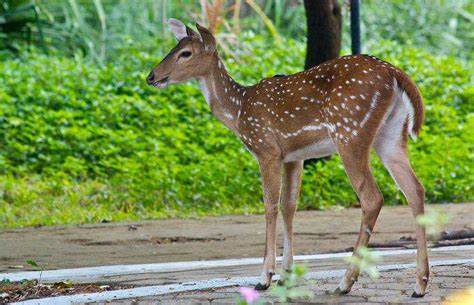
Guindy National Park : The 2.70 km - CHENNAI - Guindy National Park, is unique in more ways than one. It has the rarest vegetation type of the tropical dry evergreen vegetation adjacent to Rajbhavan. The only one of its kind in the world, located in a Metropolis. It contains more than 30 species of trees and number of century old gigantic Banyan Trees. Guindy National Park has a population of 400 black bucks, 2000 spotted deers, 24 jackals, a variety of snakes, over 100 species of birds and over 60 species of butterflies that attracts thousands of visitors to this park irrespective of age group. The park boasts of over 350 species of plants and form a natural destination for botanists. About 22 acres of this park has been carved out into a zoo for ex-situ conservation. Children's park - the zoo was established with the idea of providing children a natural environment, to educate them about animals and create awareness on conservation. The animals, have bred well in recent years. Children's park include Black Buck, Sambar, Spotted Deer, Porcupine, Hyena, Jackal, Python, Grey Pelican, Night Heron, Cormorant, Cockatiel, Mongoose, Bonnet Monkey, Common Langur. Over 7 lakh visitors visit this part every year.
Other Information Location It is adjacent to Raj Bhavan in South Madras. Area 282 hectares. Forest type Dry evergreen scrub and thorn forests. Animals found Black buck, Chital, Jackal, Pangolin and a variety of birds. Annual rainfall About 1200 mm Nearest airport Chennai airport - 8 kms Nearest Railway station Chennai Central - 12 kms Chennai Egmore - 9 kms Guindy station (Suburban Track) 1 km Season Throughout the year Accommodation Many hotels in Chennai city Other facilities Snake park and Children's park are situated within the area of the park, but have separate entrances and independent entry fees at each place. Drinking water and catering is available. For more details The Wildlife Warden, 50, IV Main Road, Gandhi Nagar, Adyar, Chennai - 600 020.Mukkurthi National Park
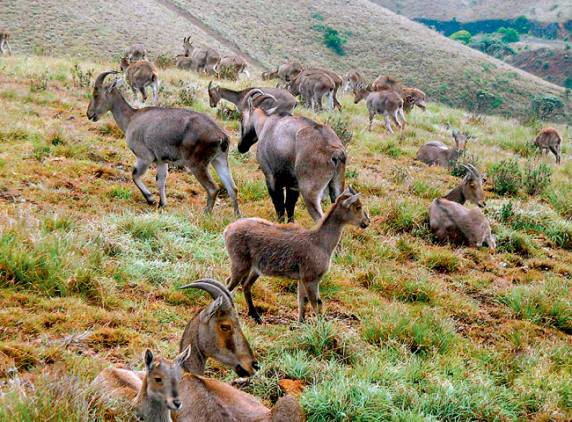
Mukurthi Peak and Mukurthi National Park : Short 45 Kms drive from Udhagamandalam, spread over an area 79 km on the south eastern corner of the Nilgiris Plateau. The Silent valley is located on the western side of this range of mountain. This park is approachable through four different routes : 1] Via Avalanchi , upper Bhavani and sanctuary begins from the dam, 2] Via Anumapuram 24 kms from Ooty near Pykara and then via Porthimund Dam to the park 3] Via T.R.Bazar and through the Terrace Estate Road, and reach Mudimund to proceed to the National park and 4] Via Parsons Valley road that leads to Western Catchment II and III. Nilgiri Tahr [earlier called as ibex or Nilgiri ibex] is found in reasonably large numbers here. This peak is compared to the peaks of Himalayan ranges in terms of the presence of Flora and Fauna unique to a geographical location of Himalayas . The entire National Park bears naturally typical high altitude vegetation like rolling grassy downs, interspersed with temperate sholas occupying slopes and valleys. The landscape is extremely picturesque and should be zealously protected and preserved to maintain the primeval beauty and grandeur of the tract. Because of its Tough Terrain and difficult accessibility , biotic interference is limited. Trekking or Driving is possible only on permitted routes.
Other Information Location It is located in the high altitudes of the Nilgiris Mountains. The landscape is extremely picturesque. This forms a part of the Nilgiris biosphere reserve. From Udhagamandalam there are four different entry points to reach this sanctuary. Area 7846 ha. of reserved forests, the entire area has been declared a National Park . Forest type Primarily grassland, characteristically interspersed with numerous isolated, compact, sharply defined wet temperate mixed forests locally termed ?sholas? with beautiful brooks cutting through the mountains. Animals found Nilgiris tahr, Sambhar, Barking deer, Nilgiris marten, Otter, Jungle Cat, Jackal etc. Avifauna consists mostly of varieties of hill birds like the laughing thrushes, whistling thrushes, woodcock, wood pigeon and black eagle may also be seen. Butterflies with Himalayan affinity like the Blue Admiral, Indian Red Admiral, Indian Cabbage white, and many others can be found here. Altitude and Annual rainfall Average elevation is around 2400 mts. Precipitation about 1300 mm. Nearest airport Coimbatore ? 140 kms. Nearest Railway station Udhagamandalam ? 45kms. Best season February to May, September to November Accommodation Forest Rest House at Avalanche, Pykara and trekking sheds. Other facilities Mainly for the tourist interested in adventure, trek routes have been formed for trekking and camping. For more details The Wildlife Warden, Mahalingam buildings, Coonoor Road, Udhagamandalam ? 643 001.Gulf Of Manner Marine National Park
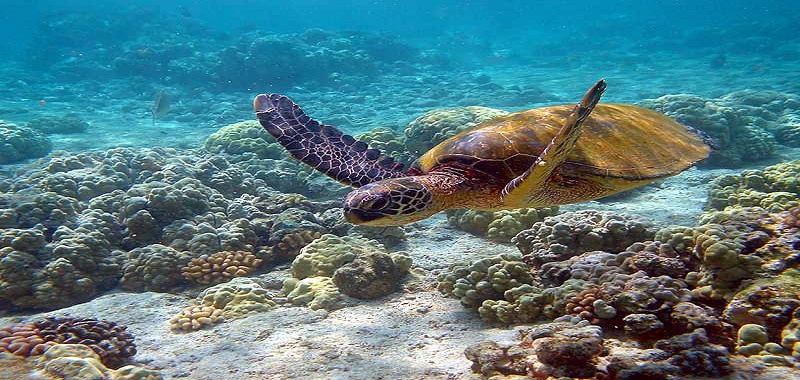
Mannar Marine National Park: This Marine park of Mannar spreads along 560 Km stretch between Rameswaram and Tuticorin. It is lying within the Bio Sphere of Mannar. Gulf of Mannar Biosphere Reserve covers an area of 10,500 Sq.KM. on the south-east coast of India. T his biosphere covers the coasts of Rameswaram, Tuticorin, Tirunelveli and Kanyakumari. It is one of the world's richest regions from marine bio diversity perspective and it is also the first marine Biosphere Reserve in Southeast Asia. The Biosphere Reserve comprises of 21 islands with estuaries, Mudflats, Beaches, Forests of the on- shore environment, including marine components like Algae communities, Sea grasses, coral reefs, Salt marshes and Mangroves. Among the Gulf's 3600 plant and animal species, there are globally endangered species of Sea Cow (Dugong) and six mangrove species endemic to peninsular India. Marakairs, a local community is engaged in fishing. The Coastal Biosphere comprises of more than 125 villages and about 1,00,000 human population. The Biosphere conservation is becoming increasingly difficult because of the Dynamite fishing, Mechanised fishing boats, danger of fishing nets hauling un-targeted marine population and Coral Population, and excessive harvesting of fish.
Other Information Location Located in the areas of Thoothukudi and Ramanathapuram districts near Mandapam ? 150 kms away from Madurai Area 623 ha. (21 islands) Marine species Characteristic tropical Flora and Fauna, Coral reefs, Dugongs, Turtles, Dolphins and Balano-glossus. Nearest Railway station Mandapam - Thoothukudi Best season Throughout the year Accommodation Hotels at Mandapam Other facilities Boats For more details The Wildlife Warden, Gulf of Mannar, Marine National Park, 76/1, Madurai Salai, Mandapam, Ramanathapuram District 623 501.Vedanthangal & Karikili Bird Sanctuary
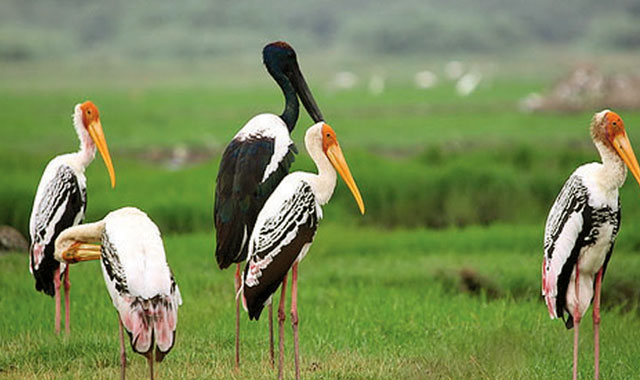
Vedanthangal Bird Sanctuary - Vedanthangal : Vedanthangal Lake is at an altitude of 122 m. This Bird Sanctuary established in 1858 in an area of 70 acres, is 85 kms from Chennai. The peak season period between November - March attracts thousands of birds like: Darter, Grebes, Egrets, White Ibis, Garganey Teals, Grey Pelican, Grey Heron, Siberian Painted Storks, Spoonbill and Spot Bill Duck from different parts of the globe, visit and breed here. Vedanthangal birds sanctuary is one of the smallest and oldest in the country with a unique history. The local people have been protecting the sanctuary for centuries now, because they have realized that the bird droppings falling into the tank increases nitrogen content of the water and when used to irrigate crop increases the yield greatly and saves the cost of fertilizers. In 1798, the village folk convinced the authorities to give protection to the birds of the 30 ha. area of the Vedanthangal tank. Around 30000 birds come every season even though the area is small in size. It then attracts multitudes of herons, egrets, storks, ibises and spoon bills. If the monsoon is heavy, these trees can be partially submerged. Despite its compact size, Vedanthangal is worth a visit, especially between October and January, for the experience of seeing nesting birds in close range.
Other Information Location Vedanthangal Karikili Kancheepuram district - 85 kms from Chennai. Area 30 hectares. + 70 hectares with a belt of 5 kms width around. Forest type A tank having a compact grove of Barringtonia acacia nilotica trees and the dry evergreen scrub and thorn forests. Animals found These sanctuaries are famous for their breeding heronry including Cormorants, Egrets, Grey heron, Open-billed stork, Darter, Spoonbill, White Ibis, Night Herons, Grebes, Grey Pelican etc . Many migratory birds like teals, shovellers, pintails, sandpipers etc. visit the sanctuary in winter. A variety of resident birds like Coots, Moorhen and Terns can also be seen . Vedanthangal is the oldest water bird sanctuary in the country. Annual rainfall About 1200 mm Nearest airport Chennai - 85 kms away Nearest Railway station Chengalpattu - 30 kms away Best Season The nesting season commences late in October and the birds are through with breeding and disperse to their feeding grounds about February. The best season is November to February. Accommodation Forest Rest House at Vedanthangal with catering arrangements, P.W.D. Rest House at Karunguzhi. Other facilities Regular bus services from Chennai, Tambaram and Chengalpattu.Crocodile Park
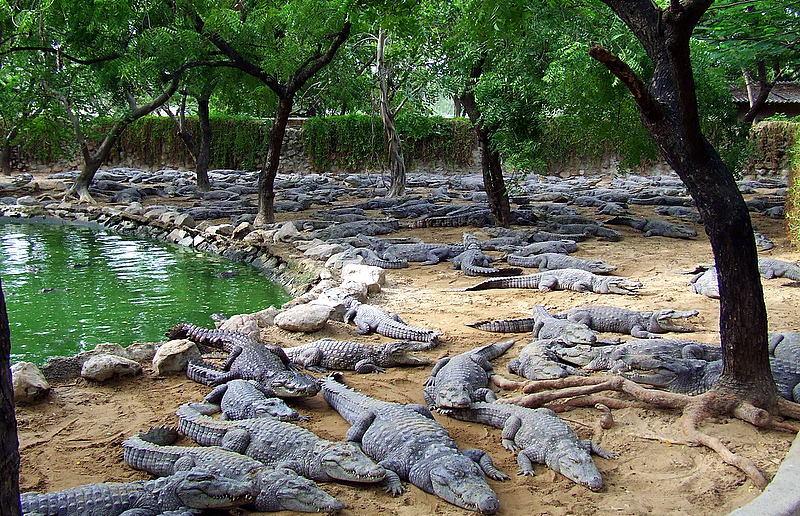
Rom and Zai Whitaker established the Madras Crocodile Bank Trust in 1976 with a specific goal of breeding the crocodile population of the Mugger (Crocodylus palustris), the Saltwater crocodile (Crocodylus porosus) and the rarest Gharials (Gavialis gangeticus). The Trust included turtles, lizards and snakes and extended the trust as the Madras Crocodile Bank Trust and Center for Herpetology in 2003. Today, after more than 30 formidable years of cutting edge science and grassroots education, the Crocodile Bank remains a world leader in the field of frontline conservation and the preservation of natural landscapes. Apart from this park, there are several field projects located throughout the subcontinent reaching as far as the Nicobar Islands. The zoo records more than half a million visitors per year making it one of the most popular tourist attractions along the East Coast Road. Their Moto and Purpose is to promote the conservation of reptiles and amphibians and their habitats through education, scientific research and captive breeding.
Mayura Thottam
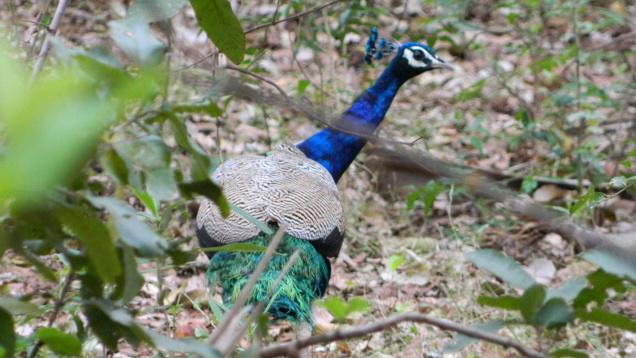
It is 22 kms from Ottapidaram of Tuticorin District. Mayurm means peacock in local language and Thottam means Garden. Large Peacock farm is located here in an area of 55 acres, hence this place is named as Mayura Thottam. The Peacocks have made this farm their home and even breed here. The entire farm is full of Coconut Groves and Guava Trees. Tourism Department has accommodation with Bed and Breakfast plan for the benefit of the tourists. October and November is the best period, when tourists can visit and enjoy the grand sight of Peacock Dance throughout the farm . Contact 0461-2366365 for further details.

Best Selling Tour Packages
Charming Hills Coastal Odyssey Southern Triangle Cultural Carnival Pilgrim Blessing Heritage Magic Wild Hills Misty Hills
Honeymoon Tour Packages
Extreme Privacy Romance @ Hills Amazing Love Love @ Coast Romantic Honeymoon Romantic Bug
Hill Station Tour Packages
Mist Valley Enchanting Hills Morning Drizzle Hills & Wildlife Wandering Hills Weekend Hills
Beach Tour Packages
Beach Fantasy Pristine Beaches Beach Wanderlust Sun N Sand Romance @ Coast Beach Nomad
Wildlife Tour Packages
Go Wild Love Tiger Amazing Wild Extreme Wilderness Wild @ Hills Wandering Wild
Temple Tour Packages
Temple Darshan Majestic Temples Magnificient Temples Historical Temples Temple Pilgrimage Vibrant Temples
Historical Tour Packages
Historical Splendor Historical Grandeur Historical Spectacle Historical Marvel Historical Glory Historical Beauty